Anna Matilda – rental permaculture in the suburbs
Ann Stanley visits the garden of Anna Matilda, from Forest Hill. As ‘The Urban Nanna’, Anna organises foraging sessions, has a popular Facebook page and maintains a substantial website about matters rental permaculture.
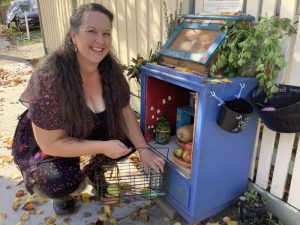 Against the picket fence around the garden of Anna Matilda’s rented home in Blackburn North is an upcycled cabinet painted cobalt blue. The door has been removed, showing off a red interior complete with a tiny mural of white flowers and a blue shelf. Inside are apples, pears (both dried and fresh), pumpkins, jars of dried lemon verbena for tea, and jars of fresh water, labelled prettily ‘feel free to fill me with fresh herbs/greens’. Potted seedlings wait on the footpath beside it. On the top sits a jar of fresh herbs, a wooden breadbox and a painted sign that reads ‘Community Corner’. The little cabinet is a beautiful example of one of the foundational ethics of Permaculture, ‘People Care’, that encourages sharing in the local community.
Against the picket fence around the garden of Anna Matilda’s rented home in Blackburn North is an upcycled cabinet painted cobalt blue. The door has been removed, showing off a red interior complete with a tiny mural of white flowers and a blue shelf. Inside are apples, pears (both dried and fresh), pumpkins, jars of dried lemon verbena for tea, and jars of fresh water, labelled prettily ‘feel free to fill me with fresh herbs/greens’. Potted seedlings wait on the footpath beside it. On the top sits a jar of fresh herbs, a wooden breadbox and a painted sign that reads ‘Community Corner’. The little cabinet is a beautiful example of one of the foundational ethics of Permaculture, ‘People Care’, that encourages sharing in the local community.
Born in Denmark to a Swedish artist mother and Australian biochemist father, Anna sees herself as part artist, part scientist. From her mother, in addition, she has inherited Scandinavian values such as ‘lagom‘ which sits at the heart of Swedish culture, in everything from sport, to food and coffee and even to manners and communication. It means something like ‘enough’ or ‘moderation in all things’. There is also the Swedish word ‘allmanslandet‘, which translates roughly to ‘the land belongs to us all’, and this shapes Anna’s approach to foraging, where it’s important never to take more than your ‘share’.
It was in childhood that Anna’s passion for foraging in nature began – she remembers gathering pussywillow and birch branches on walks, imagining she had a house in the forest. In adulthood, Anna trained and worked as a teacher (until she realised that the work was unsustainable for her). As part of her training, she specialised in the study of Autism Spectrum Disorder and has since realised that she is on the ASD spectrum. She sees this as a ‘superpower’ that allows her to understand how different people learn. She is now using the skills she developed to transfer knowledge about foraging, preserving and other ‘nanna’ skills in an urban setting.
Says Anna, “There is too much information online. You need an elder to explain. A primary teacher is uniquely placed to bring knowledge to people in digestible forms.”
Anna has developed her knowledge through courses at CERES and Burnley Horticultural College. When she completed her Permaculture Design Certificate with Milkwood Permaculture, she formed connections with the Melliodora community in Hepburn Springs. She’s sees her brand of suburban permaculture as bridging the gap between the mainstream culture and ‘hardcore’ permaculture. At the moment, ‘rental permaculture’ is her main focus.
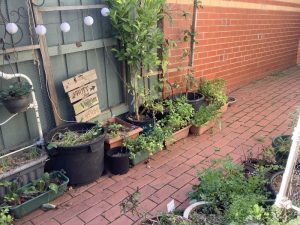 Rental permaculture comes with challenges. Anna is committed to living according to the 12 permaculture principles formulated by David Holmgren but she says that leases of variable lengths can be anxiety-producing, especially when landlords decide to sell unexpectedly. And renting does not often lend itself to retrofitting a suburban house with such things as composting toilets, water tanks and solar panels. But, says, Anna, “I do what I can. There is a lot that is achieveable, no matter where you are. You just have to tailor it.” In her previous rental in Forest Hill, she cultivated the land along the verge of the driveway, knowing how to use the edges and value the marginal, as well as having many food plants in pots.
Rental permaculture comes with challenges. Anna is committed to living according to the 12 permaculture principles formulated by David Holmgren but she says that leases of variable lengths can be anxiety-producing, especially when landlords decide to sell unexpectedly. And renting does not often lend itself to retrofitting a suburban house with such things as composting toilets, water tanks and solar panels. But, says, Anna, “I do what I can. There is a lot that is achieveable, no matter where you are. You just have to tailor it.” In her previous rental in Forest Hill, she cultivated the land along the verge of the driveway, knowing how to use the edges and value the marginal, as well as having many food plants in pots.
Inside Anna’s warm and welcoming home, the ‘house tea’ brews in a red tea pot under a handmade floral tea cozy. The tea is an infusion of foraged wild fennel seeds, apple, rose petal, rosehip, elderberry and liquorice root but it’s a tea that keeps changing depending on what is available in the garden and out in local green spaces. We drink it from teacups that are just the right size with homemade crackers that Anna flavours with fermented and dried Allium triquetrum, otherwise known as onion weed. I thought ‘house tea’ must be a Swedish tradition as it sits so well with the ideas of lagom and allmanslandet but in fact it came from Delldint, another permaculture teacher who offers an immersive permaculture course one day a week from her home in Blackburn.
 On the simple wooden table in Anna’s dining room are trays of ripening medlar and baskets of different varieties of foraged apples. Elsewhere in the spotless sun-filled kitchen, freshly washed preserving jars are draining. There is apple scrap vinegar in the fermenting corner and fire cider infused with chili, garlic galangal, apple, rosemary, thyme, lemon. This potent brew is full of Vitamin C and anti-oxidants and is apparently good as either a tonic or as an additive to salad dressings and stew.
On the simple wooden table in Anna’s dining room are trays of ripening medlar and baskets of different varieties of foraged apples. Elsewhere in the spotless sun-filled kitchen, freshly washed preserving jars are draining. There is apple scrap vinegar in the fermenting corner and fire cider infused with chili, garlic galangal, apple, rosemary, thyme, lemon. This potent brew is full of Vitamin C and anti-oxidants and is apparently good as either a tonic or as an additive to salad dressings and stew.
Books in the living room tell the story of Anna’s interests: foraging, self-sufficiency, cooking, fermenting and preserving. They “give me so much joy,” she says. Among them is one that Anna has written about how to forage for, and identify, edible fungi. This is illustrated by Brenna Quinlan, who is also the artist responsible for the illustrations in David Holmgren’s 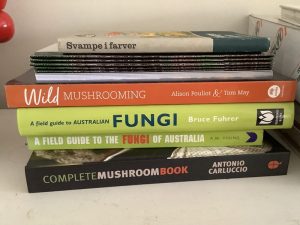 Retrosuburbia.
Retrosuburbia.
The backdoor of the kitchen leads to a small productive garden. To the west of the house is a space that traps the heat of the western sun – it is an ideal place for tomatoes in pots. Heavy mulching is used to mitigate against the effect of the heat. Lace tablecloths are used for shade when needed and, in the summer, it becomes a ‘cool grotto’. Here Anna pays attention to ‘stacking of functions’ with water overflowing from pot to pot, and growing shallow-rooted understory crops as ‘living mulch’. All the pots have no-dig layers of pea straw or leaf litter from the Manchurian pear trees growing in the street, homemade compost, and worm castings.
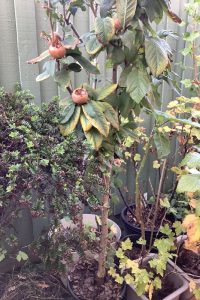 On the eastern side of the house, there is a medlar tree. There is also an apricot tree in a pot that has gone from house to house and that yielded three kilos of fruit this season. There are Jerusalem artichokes in a tub. Alpine strawberries send runners along the cracks in the concrete.
On the eastern side of the house, there is a medlar tree. There is also an apricot tree in a pot that has gone from house to house and that yielded three kilos of fruit this season. There are Jerusalem artichokes in a tub. Alpine strawberries send runners along the cracks in the concrete.
Anna grows wild brassica and bitter cress and encourages edible weeds such as chickweed and dandelion. She makes a weed pie, counteracting the bitterness of the weeds with another green that’s not too bitter.
Anna adopts a respectful, open dialogue with her landlords and agents, partly because it helps limit anxieties, but also as a time and money-saving approach: if you’ve ok’ed it with the landlord first, you won’t have to spend hours and pennies reversing it at the already-stressful time of moving house. She asks before making any changes to the property, however small, approaching the landlord with solutions rather than problems and explaining how she will improve or restore the property to the condition in which she found it upon vacation. She tries to view the problem through the lens of the landlord and apply the permaculture principle use and value diversity, in this case the diversity of landlords’ attitudes to potential modifications to their properties.
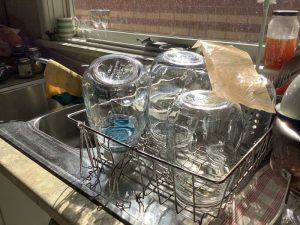 Ultimately, she would like to own her own house on a rammed earth floor so that she has a solid connection to the earth. In the meantime, Anna sees no barrier to applying the principles and practices of permaculture in all aspects of life and teaching others to do so too. For example, she observes and interacts before putting plants into to a rental garden and she uses small and slow solutions.
Ultimately, she would like to own her own house on a rammed earth floor so that she has a solid connection to the earth. In the meantime, Anna sees no barrier to applying the principles and practices of permaculture in all aspects of life and teaching others to do so too. For example, she observes and interacts before putting plants into to a rental garden and she uses small and slow solutions.
“The principles make me more confident in what I’m doing.”
There is no need for a lot of money, she says, pointing to a hard rubbish Perspex ‘greenhouse’, and bits of an old chicken coop acting as trellis, as there are so many materials that can be re-purposed and seeds that can be saved or swapped. Anna is associated with the Eastern Suburbs Permaculture Group and finds the connections that she makes there invaluable.
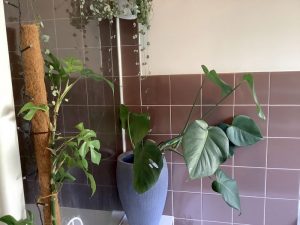 Seeking to produce no waste, Anna handwashes most of her dishes in a basin and throws the water out of the backdoor on to the garden. Her bathroom is a forest of plants and seedlings thriving in the steamy environment. Bathwater with magnesium salts goes on the plants, water infused with apple cider vinegar used as hair conditioner can safely go on the soil. And plants in the bathroom first thing in the morning promote mental health.
Seeking to produce no waste, Anna handwashes most of her dishes in a basin and throws the water out of the backdoor on to the garden. Her bathroom is a forest of plants and seedlings thriving in the steamy environment. Bathwater with magnesium salts goes on the plants, water infused with apple cider vinegar used as hair conditioner can safely go on the soil. And plants in the bathroom first thing in the morning promote mental health.
As she looks after herself and her little patch of earth, sharing with the people around her, Anna regularly asks herself, “Which principle am I enacting here?” Using the permaculture principles as thinking tools, she helps others complete a ‘life audit’. She believes in “openly and humbly sharing mistakes,” thereby modelling permaculture principle 4 – Apply self-regulation and accept feedback.
Just before I left Anna’s house, a young boy came with a box of fruit to leave at the Community Corner. “I’ll make jam with these!” said Anna. There is no doubt that a few jars of this will find their way back to the blue cabinet for people to take and enjoy.

Lovely story Ann and it sounds like Anna Matilda leads a lovely life. Well done to both of you.
I cannot believe you have the beautiful bed ends in your garden. 16 years ago I bought that exact bed for my daughter and still have it in storage, I will put it up when she leaves home. At the time I couldn’t get another as they stopped making these beds in Australia, it was originally a New Zealand company. I would be taking them back inside and looking after them, they are not cheap and will be antiques.